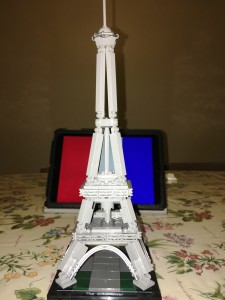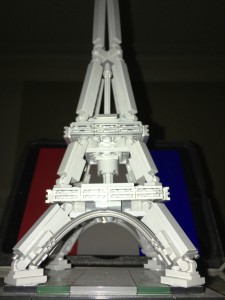
The Eiffel Tower is my third foray into the world of Lego Architecture, purchased and completed approximately one year ago (March 2015), shortly after the first inspirations of The Learning Tower of Pisa and Big Ben sets.
Key Statistics
Official Page: Lego Architecture product page
Brick Instructions: Link
Pieces: 320, 52 unique parts & 4 rare
Mini Figures: N/A
Age group: 12+
Date assembled: March 2015
Assembly duration: 2 hours
Main steps: 15
Total steps (includes repetitions & sub-components): 140
Selection & Theme
The appeal of the Eiffel Tower is hard to resist when you have an appreciation for creative and architectural designs. It is actually not clear when I acquired the set since there was no photographic evidence taken at the time
Location: Paris, France
Entrepreneur: Gustave Eiffel
Architect: Stephen Sauvestre
Engineers: Maurice Koechlin & Emile Nouguler
Materials: Wrought iron with stonework pedestals
# of Iron parts: 18,038
Weight: 10,100 metric tons including 7,300 metric tons for the iron structure
Height: 312m to the top of the flagpole; 324m when including antennas
Date: 1887 – 1889
Cost: 7.8m French gold francs
Concept
The Eiffel Tower, located on the Champ de Mars in Paris, France is the world’s most famous iron lattice structure. Named in honour of Gustave Eiffel, the engineer whose company designed and built the tower as the entrance to the 1889 World’s Fair. The World’s Fair as a concept was designed to celebrate 100 years since the French Revolution. In 1886 an official competition was held to identify a suitable centerpiece for the exhibition. With 107 project entries submitted, Gustave Eiffel’s plan was selected as the winner.
The actual concept was birthed in 1884 by the two chief engineers within Eiffel’s company and thus they receive the engineering credit above – Maurice Koechlin and Emile Nouguler. Their original design for an iron tower began with a large pylon of four latticework girder columns, separated at the base and joined as one at the apex. At regular intervals, metal girders would help to hold the structure together. Sauvestre also held creative oversight and leadership where he proposed stonework pedestral dressing of the four legs and decorative arches to link the first/lowest columns.
The initial designs were not well received but after the landmark was completed, many detractors changed their minds such that today it is considered to be a striking piece of structural art. The tower officially opened in March 1889, on schedule, with Gustave Eiffel bringing a group of government officials up to the top of the structure where a large Tricolore was unveiled to the accompaniment of a 25-gun salute. In order to get to the top an hour-long ascent on foot was required since the elevators were not yet operational.
The early years were also a tenuous time for the Eiffel Tower. The initial competition rules had required the designs incorporate the ability to easily disassemble the exhibition, but with some 2M visitors in the launch year alone, plus a short campaign to save the tower, it remained intact. In 1909 after the 20-year initial permit, ownership reverted to the City of Paris. As part of promoting the scientific interests of the Eiffel Tower, Gustave had a meteorology lab installed on the third floor and also a wind tunnel at the tower base. He personally conducted thousands of test and further encouraged other scientists to join him in studying meteorology, astronomy and physics. It was the invention of the wireless telegraph that enabled a more long-term use of the tower and ensure its future – today 120 antennas plus the television broadcast mast ensure a steady line of revenue for the Eiffel Tower. The television mast also extended the height by another 12 metres!
Design & Construction
As an end-to-end project delivery, the majority of the time was spent planning and designing the tower. Some 5000 drawings were created to help determine the required angles and degrees of precision for all the 18,038 iron parts. The foundations began being laid in January 1887 and within six months the four pedestals were ready. From July the next assembly phase commenced, which then took another 26 months.
Games like Monument Builder have been developed to simulate and provide kids today with an idea of how the whole assembly process took place. All the iron parts were pared in a factory located on the outskirts of Paris – a place called Levallois-Perret. Each piece was traced out to an accuracy of 1/10 of a millimetre before being connected to the other iron elements. As an assembled structure, the larger iron pieces were approximately five metres in length. The initial method of joining the parts was via bolts but this was later replaced by thermally assembled rivets.These rivets when cooled, contract to form a tighter fit. Steam-powered cranes were attached to the four corners of the structure within the runner space intended for the future elevators to assist with raising the iron pieces into position. Hydraulic jacks were replaced later by permanent wedges but whilst they were in use, they were key to allowing the metal girders to be positioned with an accuracy of 1 millimetre.
As the tower neared completion, many people were alarmed by its daring design and criticized Gustave for not paying enough attention to the engineering challenges involved in building the world’s tallest structure. The company was, however, masters of building complex iron bridges, and, for them, the tower project was a natural extension of the
company’s earlier pioneering work.
Lego Build
Like all Lego Architecture builds, the starting point is always the base plate, which takes form over the first five steps, culminating in the first milestone identifiable at Step 6: the black nameplate is affixed to the border. Steps 7-9 sees the first layer of the green ground layer laid out. Each of the four corners features a 2×2 turntable piece and plate top. In Steps 10 & 11 the addition of these bricks helps to conceptualise how each of the four pedestrals will be angled to fit together. Thus with the foundation complete, we put this structure to the side.
In the next section of build, the focus is the main body of the Eiffel Tower – the bottom four legs, level 1 square core and the level 2 inner core affixed to four support pillars. We build over five steps an underlying section that is then positioned under the square floor that forms level 1. Step 4 is arguably the most important part of the process because the angling of the four horizontal clip pieces will be relied upon later when the legs are joined together, between level 1 and the ground. At Step 8, use of the bracket with rounded corners combined with grille pieces create the solid border that decorates the level. Steps 9 & 10 prepare the corners in a similar fashion to Steps 10 & 11 from the ground base. Once again, the same angle/positioning of the hook studs (parallel to Step 4 earlier) prepares this level for the same style of pillars connecting this level to the next one. Step 11 creates a raised central pillar which then supports the second upper level floor. This central pillar is an extra support which simplifies the build. Step 13 outlines the four-step process for assembling each of the four legs that connects the upper level to the lower one. Step 14 is the final step where we assemble these levels together.
support pillars. We build over five steps an underlying section that is then positioned under the square floor that forms level 1. Step 4 is arguably the most important part of the process because the angling of the four horizontal clip pieces will be relied upon later when the legs are joined together, between level 1 and the ground. At Step 8, use of the bracket with rounded corners combined with grille pieces create the solid border that decorates the level. Steps 9 & 10 prepare the corners in a similar fashion to Steps 10 & 11 from the ground base. Once again, the same angle/positioning of the hook studs (parallel to Step 4 earlier) prepares this level for the same style of pillars connecting this level to the next one. Step 11 creates a raised central pillar which then supports the second upper level floor. This central pillar is an extra support which simplifies the build. Step 13 outlines the four-step process for assembling each of the four legs that connects the upper level to the lower one. Step 14 is the final step where we assemble these levels together.
Steps 15 – 17 see this upper level fully defined. Steps 18 & 19 create the same border effect from Step 8. A topping out effect is accomplished via flat-faced bricks in Step 20. The final seven-step process is repeated for each of the four bottom leg supports. To attach these legs, the model is flipped upside down, which is where the horizontal clip pieces from Step 4 come into play – the legs attach in and in the final step (main step 12). Attaching the base foundation requires the model to be flipped again. I found that in this final step, the flexibility of the model did create a slightly wonky model, but with a bit of tweaking, it was fairly straightforward to create an upright Eiffel Tower model.

You must be logged in to post a comment.